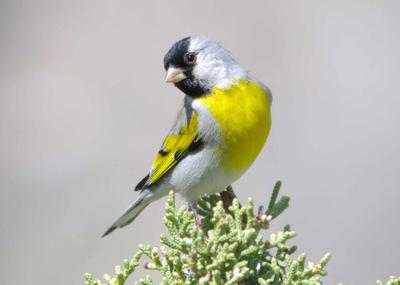Approximately 80 percent of all Lawrence’s goldfinches migrate through California's Central Valley every spring. Alan Schmierer/Flickr
California’s Central Valley and the Colorado River Delta host tens of millions birds every year during the spring migration, according to a new study published in the journal Ornithological Applications. The findings highlight the regions as critical corridors for conservation, with up to 80 percent of some species’ populations passing through the two areas.
Scientists have long suspected that the Central Valley and the Colorado River Delta were vital migratory stopovers, but “there really wasn’t any kind of science or data to back up those claims,” William DeLuca, lead author of the study and a migration ecologist for the National Audubon Society’s Migratory Bird Initiative, told Audubon magazine. “I don’t think we realized just how important they were to land birds during migration.”
Using data from the citizen science project eBird, the scientists found that more than 65 million birds travel through California’s Central Valley in the spring migration, and 48 million in the fall. Some 17 million birds pass through the Colorado River Delta in the spring, and 14 million in the fall. More than a quarter of North America’s entire tree swallow population, for example, migrates through the Colorado River Delta, which is roughly the size of the island of Hawaii. Approximately 80 percent of all Lawrence’s goldfinches fly through the Central Valley every spring, and 40 percent of all Anna’s hummingbirds pass through the valley every spring.
DeLuca and his colleagues warned that climate change, water use, and habitat loss are significantly altering the landscapes these birds have come to rely on. The Central Valley, for example, has lost most of its grasslands and wetlands to agricultural expansion and development. And the Colorado River Delta is facing severe water shortages from upstream dams and changes to precipitation patterns due to global warming, although aggressive, inter-state conservation measures are underway to restore parts of the ecosystem.
“These are really altered landscapes, but they’re still super, super important,” Deluca told Audubon. “Any information that we can use to attach a higher importance to those locations and to get more people interested only increases the probability that we can have more effective conservation.”



